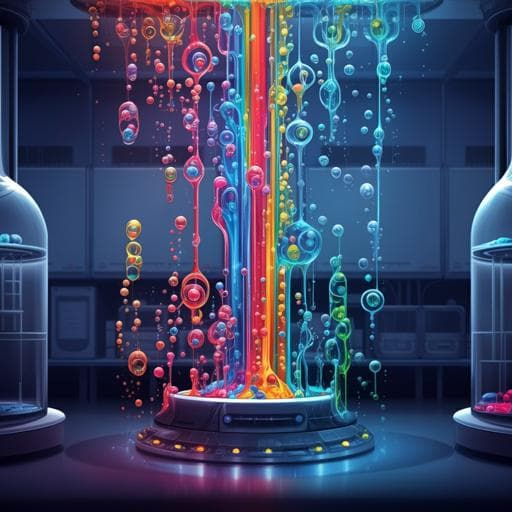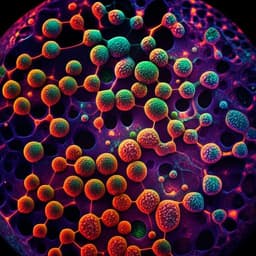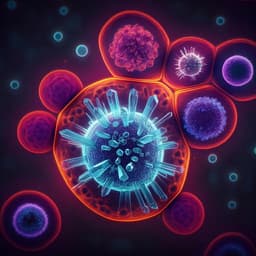
Engineering and Technology
Direct electrosynthesis and separation of ammonia and chlorine from waste streams via a stacked membrane-free electrolyzer
J. Gao, Q. Ma, et al.
Discover groundbreaking research by Jianan Gao, Qingquan Ma, Zhiwei Wang, Bruce E. Rittmann, and Wen Zhang on a novel membrane-free flow electrolyzer that transforms waste streams into valuable ammonia and chlorine gases, while efficiently minimizing reaction losses and meeting wastewater regulations.
~3 min • Beginner • English
Introduction
The study addresses how to simultaneously electrosynthesize and separate ammonia (NH3) and chlorine (Cl2) directly from nitrate- and chloride-containing waste streams using renewable-powered, membrane-free electrolysis. Conventional chemical manufacturing depends on fossil fuels and generates significant greenhouse gas emissions, whereas electrosynthesis offers a cleaner alternative compatible with intermittent renewable electricity. Wastewaters rich in electrolytes and contaminants present an underutilized feedstock for electrosynthesis, potentially reducing input costs and avoiding secondary wastes. Producing NH3 and Cl2 together is attractive because both are major global chemicals and NO3−/Cl− frequently co-occur in waste brines. However, NH3 and Cl2 react rapidly, causing product loss; traditional approaches use ion-exchange or ion-selective membranes to separate anode and cathode, but these add cost and durability challenges. The authors propose a membrane-free flow electrolyzer that couples nitrate reduction to ammonia at a Cu cathode with chloride oxidation to chlorine at a RuO2 anode and integrates gas-extraction electrodes to separate NH3 and Cl2 in situ, thereby preventing mutual quenching and enabling efficient co-production from real waste streams.
Literature Review
The paper situates its contribution within several strands of prior work: (1) Renewably powered electrosynthesis for fuels and commodity chemicals, highlighting advances in catalyst design and process integration. (2) Use of electrolytes and solvents in electrosynthesis that can increase costs and create secondary waste, contrasted with the concept of using wastewater as a resource. (3) Established electrochemical pathways: cathodic nitrate reduction to ammonia paired with anodic reactions (often oxygen evolution) and the industrial chlor-alkali process pairing chlorine evolution with hydrogen evolution. (4) Challenges in co-producing NH3 and Cl2 due to their fast homogeneous reaction, typically mitigated using ion-selective membranes, which raise capital and maintenance costs and reduce durability. (5) Emerging use of hydrophobic gas-diffusion layers and membrane modules for gas extraction and delivery in electrochemical systems. The present work leverages these insights to eliminate ion-exchange membranes by integrating gas-extraction electrodes that create localized pH microenvironments and a triphasic interface, enabling selective formation and immediate extraction of NH3 and Cl2 to minimize product loss.
Methodology
- Electrocatalysts and electrode assemblies: Metallic Cu (for nitrate reduction) and RuO2 (for chlorine evolution) were chosen due to favorable kinetics. Hierarchical Cu dendrites were electrodeposited onto a carbon-PTFE gas diffusion layer (AvCarb GDS2230) with an added PTFE hydrophobic topcoat to enhance anti-wetting. RuO2 nanoparticles were spray-coated with Vulcan XC-72 and Nafion binder onto the same substrate. Loadings: Cu 2.30 ± 0.05 mg cm−2 (electrodeposited at −0.743 V vs SCE for 700 s); RuO2 0.30 ± 0.03 mg cm−2. SEM and XRD confirmed morphology and phase.
- Gas-extraction electrode concept: The catalyst layer faces the waste stream; the PTFE gas diffusion layer faces a trap channel. Localized interfacial pH extremes from Faradaic reactions (alkaline at cathode, acidic at anode) promote vapor-phase NH3 and Cl2 formation. A vapor-pressure gradient across the hydrophobic layer drives gas transfer into separate trap streams, reducing contact between NH3 and reactive chlorine species.
- Membrane-free flow electrolyzer: Three channels in a flow cell: central waste stream channel (20 mm depth) flanked by an NH3 trap channel (acidic, pH 1 H2SO4) and a Cl2 trap channel (alkaline, pH 13 NaOH), each 30×30 mm footprint with 10 mm depth and sealed by silicone gaskets. Cu-dendrite cathode and RuO2 anode act as gas-extraction interfaces separating the waste stream from trap channels.
- Operating conditions for synthetic streams: Waste stream compositions varied: NO3− and Cl− each 10–100 mM; Na2SO4 background 0.1 M; pH 7.0 ± 0.1. Recirculation of 50 mL waste stream and 50 mL trap solutions at 25 mL min−1 using peristaltic pumps. Single-electrosynthesis (NH3-only or Cl2-only) and co-electrosynthesis were tested. Electrochemical control: for separate half-cell characterization, potentials vs RHE were controlled (cathode −0.50 to −1.0 V; anode 2.1 to 2.6 V). For full-cell co-electrosynthesis, total cell potential 2.5–3.5 V (typically 3.0 V). Current recorded with potentiostat.
- Product capture: NH3 stripped and captured in acidic trap as ammonium sulfate ((NH4)2SO4) or other ammonium salts (tested acids: H2SO4, HNO3, H3PO4, and a 1:1:1 mix). Cl2 stripped into alkaline trap to form hypochlorite (NaClO). Alternative in situ generation of acid/alkali via water electrolysis was evaluated in separate proton-exchange membrane cells for two-stage and single-stage capture.
- Analytical methods: Quantification of nitrate-N, nitrite-N, ammonia-N, and free chlorine species (HOCl/OCl−) by UV–Vis methods (details in Supplementary). Controls confirmed NH3 originated exclusively from nitrate. Calculations included yield rates, separation efficiencies, energy consumption, and material balances to infer N2 formation.
- Mechanistic probing: Control experiments varied NO3−/Cl− concentrations and ratios; introduced NO2− and NH3 together; and enabled isolation of only one gas (NH3 or Cl2) to quantify impacts on side reactions and product loss.
- Scale-up: Increased module area from 9 to 50 cm2 and stacked three tandem modules (total geometric electrode area 300 cm2), each at 3.0 V. Real reverse osmosis (RO) retentate from Yuma Desalination Plant (NO3− 11.8 mM, Cl− 54.1 mM, pH 6.6; co-contaminants present) was processed with 0.2 L trap solutions. Residual products in treated RO stream were monitored against regulatory thresholds. Continuous operation and cycling evaluated electrode/GDL stability up to >100 h. Single-pass mode (no recirculation) was also tested at various flow rates.
Key Findings
- Electrode performance and separation behavior:
- NH3 yield rate increased with more negative cathodic potential from −0.50 to −0.80 V vs RHE (from 9.8 ± 1.1 to 49.4 ± 0.7 × 10−10 M-NH3 cm−2 s−1), then plateaued; NH3 transfer rate diminished beyond −0.80 V due to H2 evolution competing for gas channels.
- Cl2 yield/transfer displayed an S-shaped response with anodic potential and reached ~35 × 10−10 M-Cl2 cm−2 s−1 above ~2.45 V vs RHE, thereafter limited by Cl− mass transfer.
- Separation efficiencies: NH3 separation showed a volcano-shaped dependence on cathodic potential with a maximum of 90 ± 2% at −0.80 V; Cl2 separation efficiency was 99 ± 1% over a wide anodic potential range.
- Co-electrosynthesis in the membrane-free electrolyzer:
- In single-electrosynthesis (5 h, 25 mM NO3− or 25 mM Cl−), trap concentrations reached 17.9 ± 0.5 mM NH3 and 9.4 ± 0.2 mM Cl2.
- In co-electrosynthesis (25 mM NO3− + 25 mM Cl−), trap concentrations after 5 h were 17.1 ± 0.2 mM NH3 and 9.3 ± 0.4 mM Cl2, close to single-baseline values; Cl2 remained undetectable in the waste stream.
- Increasing total cell potential from 2.5 to 3.5 V raised average recovery efficiency (NH3 + Cl2) from 90 ± 1% to 96 ± 1%; total product loss decreased from 12 ± 2% to 5 ± 1%, with a minimum at 3.0 V.
- Mechanistic insights and role of separation:
- Presence of Cl− increased residual NO3− and decreased NH3, with increased inferred N2, due to rapid NH3/NH4+ oxidation by HOCl/OCl− and interaction with NO2−.
- When NO2− and NH3 were co-fed with Cl−, NO2− was preferentially oxidized to NO3− initially; once NO2− was depleted, NH3 oxidation to N2 dominated, consistent with literature rate constants.
- Separating NH3 alone (>99% removed) increased NO3− conversion by 11% and reduced N2 loss by 76%; separating Cl2 alone improved NO3− conversion by 46% and reduced N2 loss by 25%, but Cl2 capture was lower than with simultaneous separation, indicating that synchronous extraction of both gases is required to minimize side reactions and product loss.
- Productivity, efficiency, and energy metrics across feed chemistries:
- With equal NO3−/Cl− increased from 10 to 100 mM at 3.0 V, energy consumption fell from 11.9 ± 0.1 to 6.3 ± 0.1 kWh per kg of aggregate solid products, while recovery efficiencies rose (95 ± 1% to 97 ± 0%) and product generation rates increased: (NH4)2SO4 from 373 ± 7 to 1763 ± 25 g m−2 d−1; NaClO from 30 ± 3 to 625 ± 14 g m−2 d−1.
- Varying NO3−:Cl− ratios (4:1 to 1:4 at 25 mM NO3−): (NH4)2SO4 rates and recovery efficiencies remained stable (556–628 g m−2 d−1; 95–98%). At high Cl− (100 mM) and NO3−:Cl− = 1:4, NaClO rate reached 962 ± 46 g m−2 d−1 (higher than 625 ± 40 g m−2 d−1 at 1:1), attributed to reduced loss of active chlorine from reaction with un-separated NH3.
- Stability >100 h with average rates of 598 g-(NH4)2SO4 m−2 d−1 and 182 g-NaClO m−2 d−1.
- Scale-up and real RO retentate (three-module stack, 300 cm2 total area, 3.0 V/module, 6 h):
- Produced 83.8 ± 16.7 mM (NH4)2SO4 and 243.4 ± 15.6 mM NaClO; nitrogen and chlorine utilization efficiencies of 71% and 45%.
- Electrical consumption: 7.1 kWh per kilogram of aggregate solid products.
- Residuals in treated RO stream: NH3/NH4+ 0.32 ± 0.19 mM, Cl2/HOCl/OCl− 0.06 ± 0.02 mM, NO2− 0.15 ± 0.08 mM—meeting or below relevant discharge limits.
- Techno-economics and operations:
- TEA (electricity at $0.05/kWh; market prices for (NH4)2SO4 and NaClO): projected profit ~$1550 per metric ton product for synthetic streams and ~$2364 for real RO stream at industrial scale; profitability sensitive to energy intensity and electricity price.
- Alternative acids for NH3 capture showed comparable efficiencies; in situ acid/base single-stage capture caused ~85% Cl2 loss due to cross-reactions, favoring two-stage operation.
- Single-pass mode achievable; NH3 separation efficiencies 54–71% depending on flow, with Cl2 separation >99% and residual active chlorine <0.01 mM; flow control is critical for regulatory compliance.
Discussion
The work demonstrates that pairing nitrate reduction to ammonia with chloride oxidation to chlorine in a single, membrane-free flow electrolyzer can deliver efficient, simultaneous production and in situ separation of both gases directly from waste streams. The integrated gas-extraction electrodes create interfacial environments that promote vapor-phase NH3 and Cl2 and enable immediate transfer into dedicated trap solutions, thereby minimizing their mutual reaction, which otherwise causes substantial product loss and formation of benign end products (N2 and Cl−). By tuning cell potential and synchronizing extraction on both electrodes, the system attains high recovery efficiencies (up to ~96%) while maintaining low losses, with performance improving at higher ionic strengths typical of brines. Scale-up to a three-module stack processing real RO retentate confirms feasibility, achieving substantial concentrations of (NH4)2SO4 and NaClO at modest electrical intensity (7.1 kWh per kg aggregated solids) and leaving residual nitrogen and chlorine species below discharge thresholds. Mechanistic controls validate that synchronous separation is essential: isolating only NH3 or only Cl2 is insufficient to mitigate side reactions of HOCl/OCl− with NH3/NO2−. Collectively, these findings address the core challenge—preventing NH3–Cl2 cross-reactions without costly ion-exchange membranes—while leveraging wastewaters as electrolytes to reduce inputs and enable circular resource recovery.
Conclusion
This study introduces a membrane-free, flow-type electrolyzer that couples electrosynthesis with interfacial gas extraction to co-produce and separate NH3 and Cl2 from nitrate- and chloride-containing waste streams. Using Cu and RuO2 gas-extraction electrodes, the system achieves high product purities, high recovery efficiencies, and low product losses by synchronizing formation and transfer across hydrophobic diffusion layers. The approach scales to a stacked configuration (300 cm2) and processes real RO retentate, yielding concentrated (NH4)2SO4 and NaClO with electrical consumption of 7.1 kWh per kg of aggregate solids and compliant residuals. A preliminary TEA indicates attractive economics under favorable energy intensity and electricity costs.
Future research directions include: expanding to additional bulk and fine chemicals; integrating pre-concentration for dilute waste streams; optimizing reactor architectures (e.g., zero-gap, flow-through electrodes) and catalyst layers to overcome mass-transfer limits; coupling with porous adsorbents; refining synchronization of gas extraction kinetics; and broader on-site deployment at wastewater facilities to enhance circularity and move toward zero liquid discharge.
Limitations
- Performance depends strongly on waste stream chemistry (NO3−/Cl− concentrations and ratios, co-contaminants), which influences kinetics, recovery, and energy use; pre-conditioning or pre-concentration may be required for dilute feeds.
- Synchronous extraction of both NH3 and Cl2 is critical; isolating only one gas leads to side reactions and product loss. Cl2 extraction kinetics can be limiting without concurrent NH3 removal.
- In situ single-stage acid/base generation caused substantial Cl2 loss (~85%) due to redox interactions; two-stage operation or physical separation is needed, adding complexity.
- Chlorine utilization efficiency in the scaled RO test was moderate (45%), indicating room to improve anodic selectivity and capture kinetics.
- Stability demonstrated to >100 h; longer-term durability, fouling of GDLs, and maintenance under real wastewater matrices remain to be validated.
- Profitability is sensitive to electricity price and energy intensity; process optimization and integration with low-cost renewable energy are essential.
Related Publications
Explore these studies to deepen your understanding of the subject.







